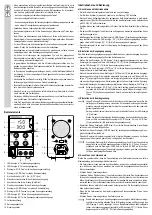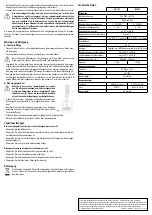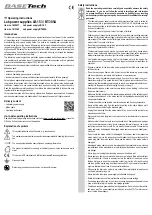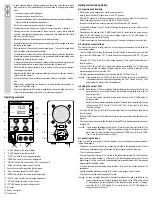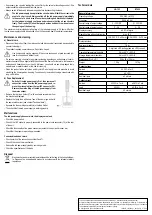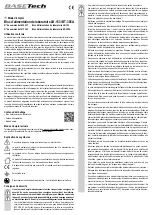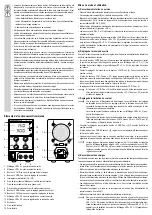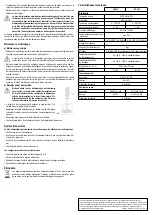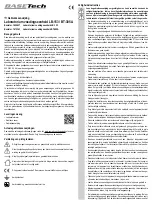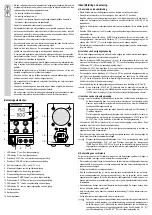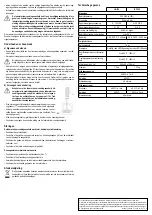
• In case safe operation is no longer guaranteed, cease use of the device immedi-
ately and shield it from unintended use. Safe operation is no longer guaranteed
when:
- the power supply is visibly damaged,
- the power supply no longer functions,
- the power supply was stored for an extended period under adverse conditions or
- if the product was damaged during transport.
• Do not use the laboratory power supply as a charger.
• The laboratory power supply is not approved for use on persons or animals.
• Opening any covers on the product or removing parts – unless this is possible
by hand – may expose voltage-carrying components. This poses the risk of fatal
injury due to electric shock!
• Disconnect the device from the power outlet before opening it.
• Capacitors located in the laboratory power supply may still be charged even when
the device is unplugged.
• Only use fuses of the specified type and rated current. The use of mended fuses
is not permitted as this poses a fire hazard!
• For installations in industrial facilities, follow the accident prevention regulations
for electrical systems and equipment of the government safety organization or the
corresponding authority for your country.
• In schools and educational institutions, hobby and do-it-yourself workshops, the
use of the laboratory power supply must be supervised by trained staff.
• Please handle the product carefully. Jolts, impacts or a fall even from a low height
can damage the product.
• Also observe the safety and operating instructions of any other devices which are
connected to the product.
• Consult an expert when in doubt about operation, safety or connection of the de-
vice.
• Maintenance, modifications and repairs are to be performed exclusively by an
expert or at a qualified shop.
• If you have questions which remain unanswered by these operating instructions,
contact our technical support service or other technical personnel.
Operating elements
13 ______
14 _________
15 ________
____ 12
____ 11
_____ 10
_____ 9
___
8
___
7
___
6
1 ________
2 ________
3 _____
4 _____
5 __
USE ONLY WITH 250 V FUSE
1 “V” LED display for the output voltage
2 “A” LED display for the output current
3 “VOLT Fine” knob for fine voltage adjustment
4 “CURR Fine” knob for fine current adjustment
5 “ON/OFF” switch (ON = switched on, OFF = switched off)
6 “Minus” connection socket for the DC output
7 Connection socket for grounding (yellow-green)
8 “Plus” connection socket for the DC output
9 “CURR Coarse” knob for coarse current adjustment
10 “VOLT Coarse” knob for coarse voltage adjustment
11 “CC” LED display for output current control
12 “CV” LED display for output voltage control
13 Air outlet
14 Power input socket
15 Fuse holder
Getting started and operation
a) Connection and Start-Up
• Place the lab power supply on an sturdy and even surface.
• Initially, the on/off switch (5) should be in the “OFF” position.
• Plug the IEC connector of the supplied power cord into the power input (14) on the back of
the unit and plug the power cord into a 230 V/AC, 50 Hz AC outlet.
• Now switch on the lab power supply by pressing the on/off switch (5) (“ON” position).
• The two LED displays (1 and 2) will be lit showing the currently set current value and the
voltage value.
• Depending on the position of the “CURR Coarse” knob (9), which limits the output current,
either the “CV” LED display (12) for the output voltage control or the “CC” LED display (11)
for the output current control will light up.
• The lab power supply is now ready and you can set the output voltage and the current limit.
b) Setting the output voltage
The output of the lab power supply must be in the voltage-controlled state in order to set the
correct output voltage.
• Turn the “CURR Coarse” knob (9) clockwise from the left stop to the output current limit until
the current limit LED display “CC” (11) turns off and the voltage control LED “CV” (12) goes
on.
• Check the “VOLT Fine” knob (3) for fine voltage adjustment. This control knob should be in
the mid-position.
• Turn the “VOLT Coarse” knob (10) to roughly the desired output voltage. The “V” LED display
(1) shows the currently set voltage. Voltage increases, when the knob is rotated CW and
decreases when the knob is rotated CCW.
• The output voltage is then adjusted to an exact value with the “VOLT Fine” knob (3).
If you need to turn the “VOLT Fine” knob (3) all the way to the stop, move it back to
the middle position and adjust the voltage using the “VOLT-Coarse” knob (10). Then
adjust further by means of the fine adjustment.
c) Setting the current limit
Read section “d) Connecting loads” before attempting to set any current limits. You
have to switch on a connected load and the lab power supply to be able to set the
exact current limit.
You can only read the current limit value, which is shown in the “A” LED display (1),
during operation.
Adjust first the permissible operating voltage of the load to be operated with the two
voltage controls “VOLT Coarse” (10) and “VOLT Fine” (3) (see chapter “b) Setting
the output voltage”).
• Check the “CURR Fine” knob (4) for fine current adjustment. This control knob should be in
the mid-position.
• With the “CURR Coarse” knob (9) adjust the output current limit roughly to the desired current
strength.
• The current value increases, when the knob is rotated CW and decreases when the knob is
rotated CCW.
If both voltage adjustment knobs (3 and 10) are turned all the way to the left, the
voltage display shows “00.0” volts. The lab power supply is in the current-controlled
state if after that also the output current limit knobs “CURR Coarse” (9) and “CURR
Fine” (4) are turned all the way to the left.
d) Connecting the loads
Make sure that the total power of all loads together is not exceeding the maximum power of
the lab power supply.
• The loads must be switched off when connecting the loads to the lab power supply. If this is
not the case, possible sparking can damage the output sockets and also the plugs.
• Turn the lab power supply off.
• Connect the positive terminal (+) of the load to the red positive terminal (8) of the lab power
supply and the minus terminal (-) of the load to the black negative terminal (6) of the lab
power supply. For this you should use adequately dimensioned cables with 4 mm banana
plugs or standardized lab cables.
• You can attach cable strands using screw terminals. To this end, the socket heads can be
screwed on.
• Use the dedicated ground connection (7) of the lab power supply to earth the load.
• Then switch on the lab power supply and the load.
As soon as voltage is applied to the output sockets and the load is switched on, the
current values for current limit and voltage will be shown on the LED displays (1 and
2). Depending on the operating mode of the lab power supply (current- or voltage-
controlled), the “CC” LED display (11) for current limit or the “CV” LED display for
voltage control (12) will be lit.


